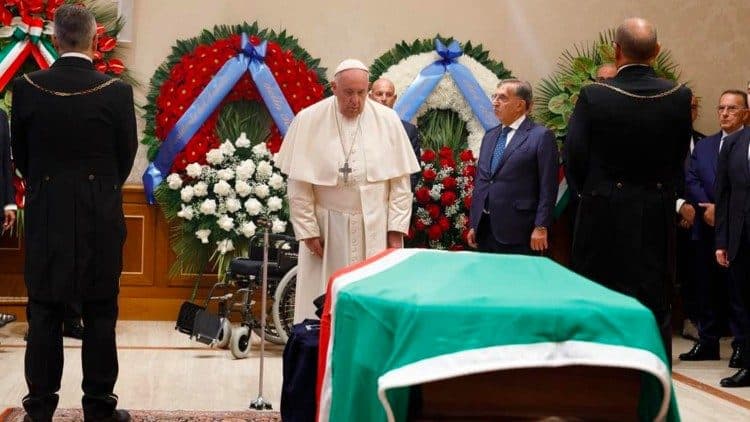ROME – Francis always has been a pope of firsts, and on Sunday he added another novelty to the list, becoming history’s first pope to set foot inside the Italian Senate in order to pay his respects to former President Giorgio Napolitano, who died Friday at the age of 98.
After having returned late Saturday from an overnight trip to Marseille, Pope Francis left the Vatican on Sunday shortly after his noontime Angelus address to arrive at Rome’s Palazzo Madama, the headquarters of the Italian senate, where Napolitano’s body was lying in state.
Napolitano, a former leader of Italy’s Communist party, was a non-believer, and in accord with his wishes, his funeral Tuesday will be a civil ceremony, marking the first time in Italian history that a former head of state will not receive a Catholic funeral Mass.
RELATED: A non-believer’s legacy holds Catholic lessons for politics, and for friendship
Nevertheless, in a sign of the respect Napolitano always showed to the Church and its leaders, Italian Cardinal Gianfranco Ravasi, a longtime personal friend, will be among the speakers paying tribute during the ceremony.
In a brief note to reporters announcing the pope’s visit, the Vatican said Francis made the visit “in order to express, with his presence and his prayer, his personal affection to [Napolitano] and his family, and to honor the great service he rendered to Italy.”
After arriving in the chamber of the senate in a wheelchair, the 87-year-old pontiff rose using a cane and stood in silence for several moments of silence before the coffin containing Napolitano’s remains, which was draped in the Italian flag.
Francis then greeted Napolitano’s widow, Clio Maria Napolitano, who was also seated in a wheelchair.
In a telegram dispatched after Napolitano’s death, Francis already had expressed “feelings of emotion and gratitude.”
“I appreciated the humanity and foresight in making important choices correctly, especially in delicate moments for the life of the country, with the constant intention of promoting unity and harmony in a spirit of solidarity, animated by the search for the common good,” the pontiff said.
Napolitano joined Italy’s Communist party in 1945 after having participated in the anti-fascist resistance during World War II, and went on to be elected to Italy’s Chamber of Deputies for the first time in 1953. He became a leader of the various leftist coalitions that followed the dissolution of the Communist party, and was elected to the Italian presidency in 2006.
Though the presidency in Italy is largely a ceremonial role, Napolitano nevertheless is credited with having skillfully overseen the end of the term of former Prime Minister Silvio Berlusconi in 2011 amid a massive debt crisis, engineering a transition to respected economist Mario Monti that many observers credit with saving Italy from financial collapse.
Napolitano reluctantly accepted reelection in 2013, becoming the first Italian president ever to serve a second term and the longest-serving head of state since the foundation of the Italian republic in 1946.
The non-believing Napolitano nevertheless enjoyed close personal friendships both with Pope Benedict XVI and with Pope Francis.
Benedict XVI once said of Napolitano, “For Italy, it was certainly fortunate to be guided in difficult times, among obstacles of all kinds, by a man like that.” In turn, Napolitano was one of the few people to whom Benedict XVI revealed his plan to resign in February 2013 in advance.
Ravasi said that Francis’s physical presence on Sunday was “not only a gesture of institutional respect, but also respect for a man who always had within himself a moral dimension and an openness to what goes beyond appearances.”
“Let us never forget that Christ did not hesitate to go into highly secular environments,” Ravasi said. “This is the strength of Christianity: not being closed in its protective garden but listening to what lies beyond and to the other who listens to you.”












